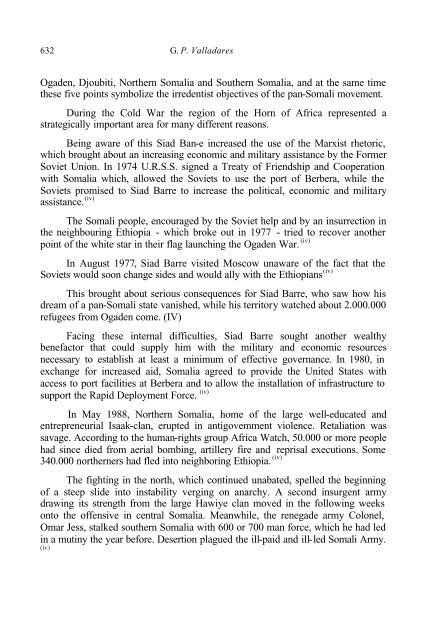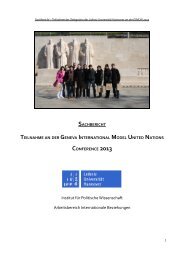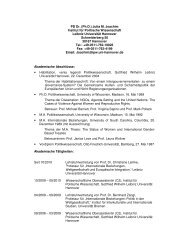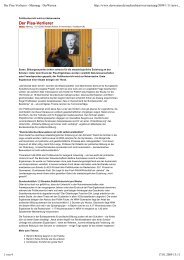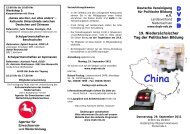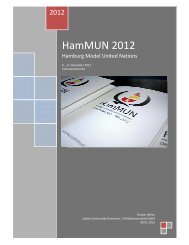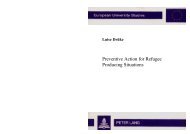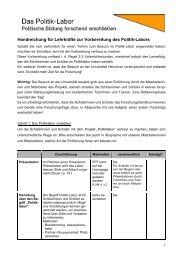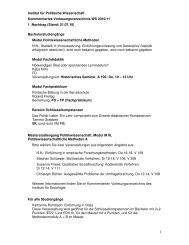SOMALIA HUMANITARIAN INTERVENTION 1992-1993 by G. P. ...
SOMALIA HUMANITARIAN INTERVENTION 1992-1993 by G. P. ...
SOMALIA HUMANITARIAN INTERVENTION 1992-1993 by G. P. ...
You also want an ePaper? Increase the reach of your titles
YUMPU automatically turns print PDFs into web optimized ePapers that Google loves.
632 G. P. Valladares<br />
Ogaden, Djoubiti, Northern Somalia and Southern Somalia, and at the same time<br />
these five points symbolize the irredentist objectives of the pan-Somali movement.<br />
During the Cold War the region of the Horn of Africa represented a<br />
strategically important area for many different reasons.<br />
Being aware of this Siad Ban-e increased the use of the Marxist rhetoric,<br />
which brought about an increasing economic and military assistance <strong>by</strong> the Former<br />
Soviet Union. In 1974 U.R.S.S. signed a Treaty of Friendship and Cooperation<br />
with Somalia which, allowed the Soviets to use the port of Berbera, while the<br />
Soviets promised to Siad Barre to increase the political, economic and military<br />
assistance. (iv)<br />
The Somali people, encouraged <strong>by</strong> the Soviet help and <strong>by</strong> an insurrection in<br />
the neighbouring Ethiopia - which broke out in 1977 - tried to recover another<br />
point of the white star in their flag launching the Ogaden War. (iv)<br />
In August 1977, Siad Barre visited Moscow unaware of the fact that the<br />
Soviets would soon change sides and would ally with the Ethiopians (iv)<br />
This brought about serious consequences for Siad Barre, who saw how his<br />
dream of a pan-Somali state vanished, while his territory watched about 2.000.000<br />
refugees from Ogaden come. (IV)<br />
Facing these internal difficulties, Siad Barre sought another wealthy<br />
benefactor that could supply him with the military and economic resources<br />
necessary to establish at least a minimum of effective governance. In 1980, in<br />
exchange for increased aid, Somalia agreed to provide the United States with<br />
access to port facilities at Berbera and to allow the installation of infrastructure to<br />
support the Rapid Deployment Force. (iv)<br />
In May 1988, Northern Somalia, home of the large well-educated and<br />
entrepreneurial Isaak-clan, erupted in antigovemment violence. Retaliation was<br />
savage. According to the human-rights group Africa Watch, 50.000 or more people<br />
had since died from aerial bombing, artillery fire and reprisal executions. Some<br />
340.000 northerners had fled into neighboring Ethiopia. (iv)<br />
The fighting in the north, which continued unabated, spelled the beginning<br />
of a steep slide into instability verging on anarchy. A second insurgent army<br />
drawing its strength from the large Hawiye clan moved in the following weeks<br />
onto the offensive in central Somalia. Meanwhile, the renegade army Colonel,<br />
Omar Jess, stalked southern Somalia with 600 or 700 man force, which he had led<br />
in a mutiny the year before. Desertion plagued the ill-paid and ill-led Somali Army.<br />
(iv)


